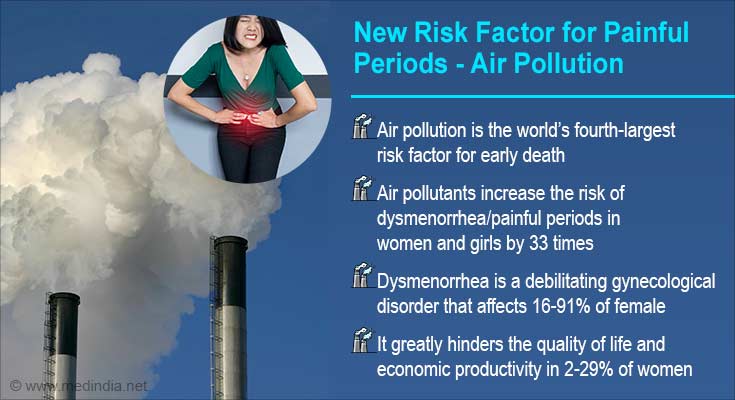Depending upon the level of exposure to the pollutants, the health risk posed by it differs. It has been documented in various studies regarding the ill effects that air pollutions cause on the reproductive health of women.
are commonly associated with a mild degree of pain along with a set of ill symptoms (bloating, headaches, or mood swings) usually preceding the periods –
However, if the pain is severe along with debilitating cramps (usually in the lower abdomen due to abnormal contractions of the uterus), it is referred to as dysmenorrhea. Other symptoms that accompany this painful condition are lower back and leg pain, nausea, vomiting, diarrhea, fainting, weakness, fatigue, and headaches.
It is a common gynecological disorder that affects 16-91% of girls and women of reproductive age. It occurs due to hormonal imbalances or conditions such as endometriosis, pelvic inflammatory disease, ectopic pregnancy, or tumors in the pelvic cavity. The other risk factors for dysmenorrhea include smoking, drinking alcohol, overweight, early menarche, and late pregnancy or nulliparous.
Although many tend to ignore this common problem of women, it greatly hinders the quality of life (in 2-29% of women) and economic productivity of women. Presently there is no known cure for the disorder and only symptomatic management with drugs like painkillers and hormonal contraceptives are done.
First Epidemiological Study
The present study for the first time, examined the data on mean exposure to various air pollutants from the ‘Taiwan Air Quality Monitoring Database’ (TAQMD) of the Environmental Protection Agency and Taiwan’s nationwide health insurance database with a total of 296,078 women and girls (approximately 1.3% of the total population) between 16-55 years old.
It states that Taiwanese women and girls who have long-term exposure (over 13 years, 2000-2013) to air pollutants such as carbon and nitrogen oxides and fine particulate matter, have 33 times increased risk of developing dysmenorrhea. The risk was compared with their peers who had lower exposure levels of pollutants.
Air pollutants – Adds to List of New Risk Factor
The study found that almost 4.2% of women and girls were diagnosed with dysmenorrhea for the first time. Moreover, 25% of the high air pollutant areas had the ‘hazard ratio’ (that is, the age- and year-specific risk) of developing dysmenorrhea raise from 16.7 to 33.1 fold for women and girls, when compared to 25% of lowest exposed areas.
The size of the air particles also determines the extent of the impact on health. Finer particles (
Among the pollutants, high exposure to PM2.5 (particulate matter smaller than 2.5 microns) was the greatest contributor to the risk factors. Hence these particles can add devastating effects on periods of women with other associated complications like developing fibroids.
“Our results demonstrate the major impact of the quality of air on human health in general, here specifically on the risk of dysmenorrhea in women and girls. This is a clear illustration of the need to for actions by governmental agencies and citizens to reduce air pollution, in order to improve human health,” says one of the authors, Prof Chung Y. Hsu at the College of Medicine, China Medical University, Taichung, Taiwan.
How Air pollution Links to Dysmennorhea?
Although the exact mechanism of how air pollution contributes to painful periods is unknown, the study authors speculate that emotional stress in women who have exposure to air pollutants, or higher average levels of the hormone-like prostaglandins in their body may cause this increased risk.
Other studies state that air pollution may provoke systematic inflammation on exposure to PM2.5 that further causes oxidative stress and cellular injury. All these factors may cause to irregular menstrual cycle and dysmenorrhea.
Tips to Avoid Air Pollution
- Minimize outdoor exposure to air pollution.
- Try wearing a mask in heavily polluted areas like urban environments.
- The air pollution levels can be monitored from data provided by agencies like Environmental Protection Agency or through a system for air pollution alerts.
- Adopt indoor activities for physical fitness or exercises in polluted areas
- Contribute your part in reducing air pollution by adopting greater fuel efficiency vehicles like public transport
- Use energy-efficient electrical appliances and avoid products utilizing fossil fuels
Facts on Air Pollution
- Globally 9% of deaths are caused due to air pollution.
- It also causes various other diseases like cancer, heart diseases, infertility, genetic disorders, and various respiratory diseases, thereby being a leading cause of disease burden.
- Countries with low-to-middle income have the highest rate of death from air pollution that is, 100-fold differences in rates across other countries.
- The burden of indoor air pollution also causes several non-communicable diseases around the world.
- Almost 3 billion people cook using polluting open fires (kerosene, biomass, and coal).
- Inhalation of particulate matter from household air pollution results in half of the deaths among children under 5 years of age due to pneumonia
References:
- Study is first to show that air pollutants increase risk of painful periods for women – (https://blog.frontiersin.org/2021/07/07/public-health-air-pollution-increases-risk-dysmenorrhea/)
- Increased Incidence of Dysmenorrhea in Women Exposed to Higher Concentrations of NO, NO2, NOx, CO, and PM2.5: A Nationwide Population-Based Study – (https://www.ncbi.nlm.nih.gov/pmc/articles/PMC8247898/)
- Smoggy Air Might Raise Black Women’s Odds for Fibroids
– (http://healthlibrary.brighamandwomens.org/Library/News/Headlines/6,1652960466) - How Smoke from Fires Can Affect Your Health
– (https://www.epa.gov/pm-pollution/how-smoke-fires-can-affect-your-health) - Does air pollution make outdoor exercise risky? What if you have asthma or another health problem? – (https://www.mayoclinic.org/healthy-lifestyle/fitness/expert-answers/air-pollution-and-exercise/faq-20058563)
- Household air pollution and health
– (https://www.who.int/news-room/fact-sheets/detail/household-air-pollution-and-health)
Source: Medindia



